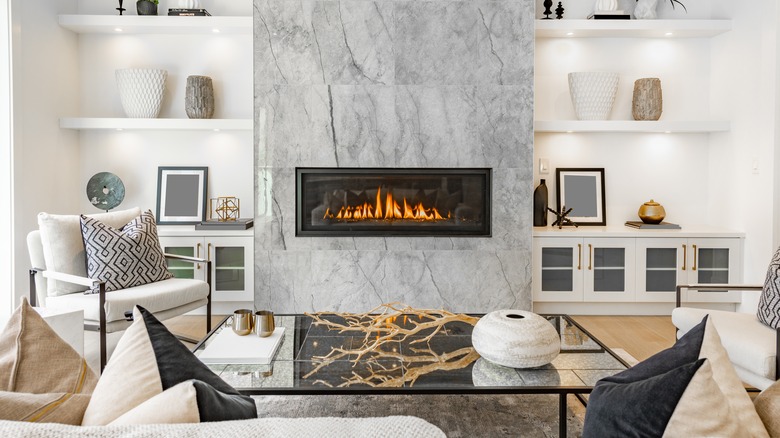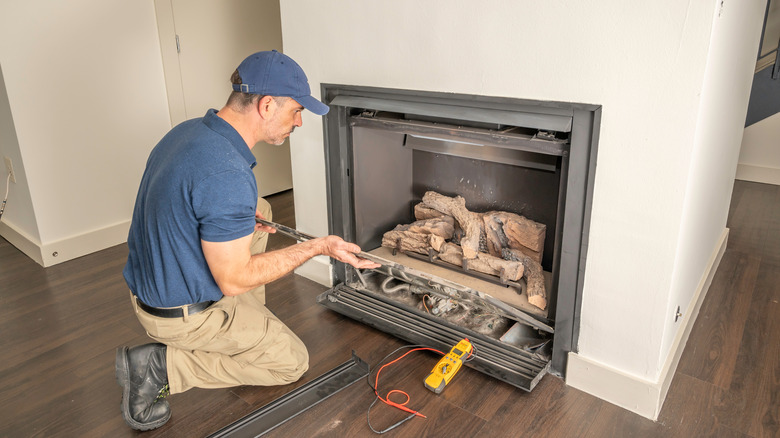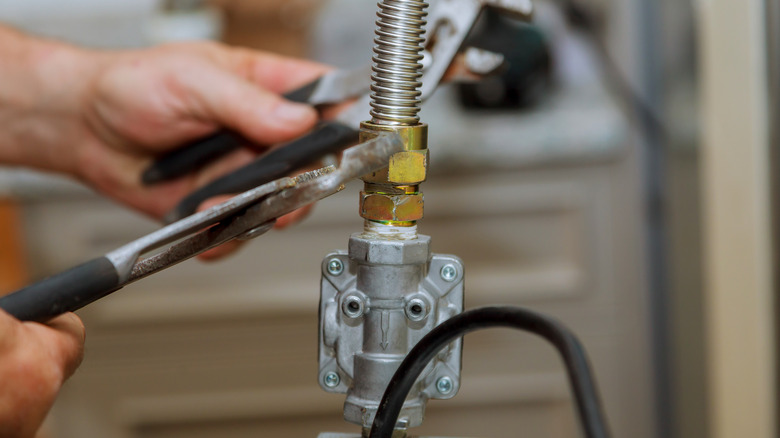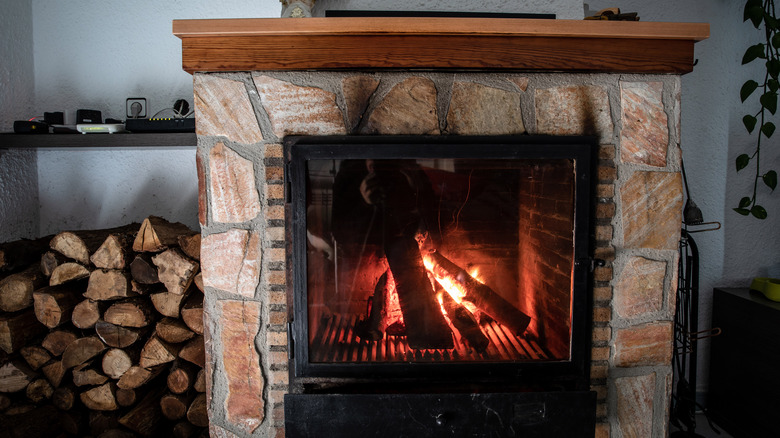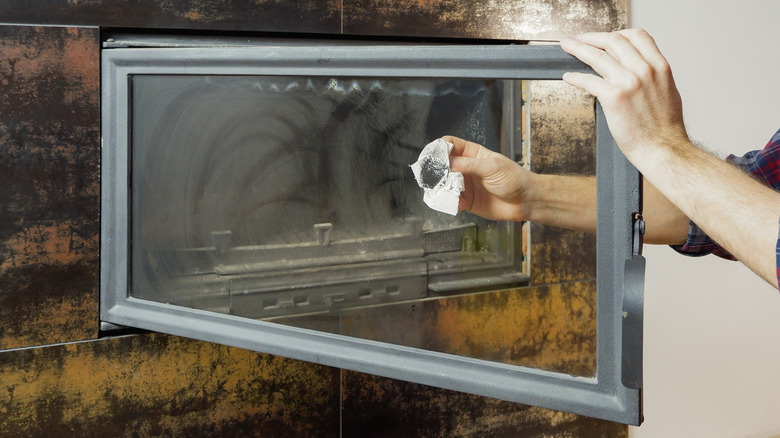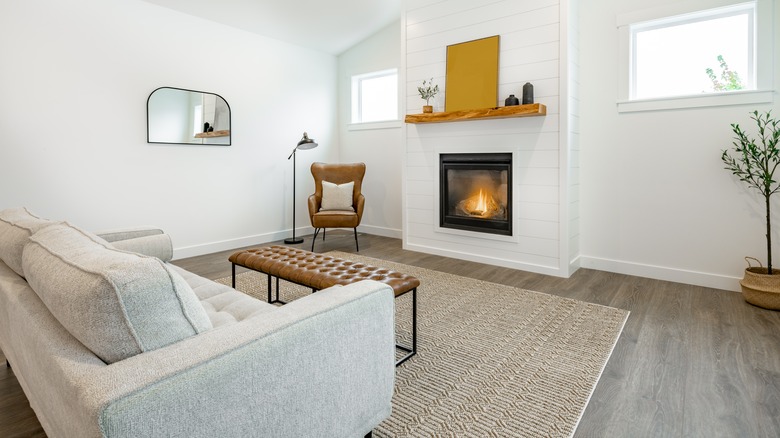How Much Does It Cost To Put In A Gas Fireplace?
What better way to enjoy the cold winter months or chilly spring evenings than cuddling next to a warm, cozy fire while the weather does its thing outside? Whether it's time to upgrade your outdated fireplace or add a completely new addition to your home, a gas fireplace may be worth the investment. Gas furnaces are quickly becoming a popular choice across the United States, and it is not hard to see why. Kozy Heat Fireplaces states that not only can a gas fireplace be a beautiful addition to your home, but it is also very easy to maintain and burns in a clean way that is good for both you and the surrounding environment.
Out of the eight types of gas fireplaces you can choose from for your home, Superior Fireplaces notes that the top three types include the B-vent, vent-free, and direct vent fireplaces. Each of these three kinds carries a different strength that appeals to different people, whether that be aesthetic appeal, functionality, or heat efficiency. Regardless, on average, you can expect to spend between $2,300 and $10,000 to install a new gas fireplace, per HomeAdvisor. This price is highly dictated by the type of furnace you want and the existence or non-existence of a previous fireplace. Keeping your desires and budget in mind, let's take a closer look at what it takes to install a gas fireplace and discover if it is truly worth your investment.
Factors for cost
Before diving into a major home project, it's important to first break down all the pieces needed for the successful completion of the project and analyze how each of these aspects will factor into the entire project's cost.
Materials
HomeAdvisor states that for an average fireplace, materials should cost between $600 and $3,400, with most people spending around $2,000. However, keep in mind that this price range can quickly rise if you decide to make your fireplace bigger or fancier than average. In addition to the furnace itself, you may also decide to add or replace a vent or chimney, adding to the cost of materials.
Labor
Depending on the professionals you decide to hire for your gas fireplace project and the extent of the work, labor can cost you anywhere from $200 to $5,000. Expect a small price for simpler projects and a higher price for a more elaborate job. Adding a vent or chimney to your new gas furnace can also raise the price even further with an additional labor cost that ranges between $400 and $6,000, HomeAdvisor notes.
Permits
According to Fast Fireplaces, nearly every state requires a permit to install gas piping or electrical modifications for any home or business. Most professionals are familiar with these types of permits and are able to help you obtain one, but it will add additional costs to your overall project. HomeAdvisor states that you can expect to pay between $100 and $400 for installation permits, which is highly dependent on the state your home is located in and the type of system you wish to install.
Additional costs
In addition to the simple cost of building the gas fireplace, some other additional expenses need to be considered regarding the new fireplace's ability to function.
Gas lines
For your gas fireplace to function properly, you must hook it up to a steady and safe gas stream; the cost of the gas line mainly depends on the length, Fireplaces Direct explains. On that end, HomeGuide notes that the average cost of running a gas line is between $355 and $743; however, depending on the job's complexity, the costs can also go up to $1,000. Nevertheless, expect to pay around $12 to $25 per linear foot for an average installation.
Usage
It's important to remember that even after fully installing your gas fireplace, it will still cost you money to use it. Depending on the type of gas you use for your furnace, it could cost more or less than $0.70 per hour to run, Fireplaces Direct notes. This make makes the average yearly price $60. On the other hand, propane gas has a much higher price of approximately $2.30 an hour to run, making the average yearly price $200.
Types of gas fireplaces
When you decide to invest in a new gas fireplace, you have several different options to choose from, ranging widely between styles and functionality. Superior Fireplaces mentions the three most popular types: the B-vent gas fireplace, vent-free fireplace, and direct vent fireplace. Let's take a closer look at these three common furnace types below.
B-vent gas fireplace
If a traditional-looking fireplace is important to you, the B-vent furnace may be the perfect fit. This type is usually only picked for its appearance, as it has that traditional open-front fireplace look but is known for being very easy to control when it comes to the use of gas. Because B-vent gas fireplaces are designed with an open front, they draft vertically by drawing air out of the room. Nevertheless, you can adjust this design by giving the furnace a glass front and access to outside air, which would make it draw more air from the outside rather than from the room.
Vent-free gas fireplace
If efficiency is more important than style, then a vent-free gas fireplace is a great choice for you. Because there is no vent connected to the outside, all the heat this type produces remains in the fireplace area. There is a downside, however, to a vent-free gas furnace. Because it is not connected to the outside air, moisture tends to build up rather quickly with its use. This furnace must also be properly sized to be directly proportional to the room you want to place it in or at least check to see if it fits the type of home you live in.
Direct vent gas fireplace
If you are looking for a gas furnace that offers both great style and heating efficiency, the direct vent gas fireplace is the best option you've got. These types of fireplaces are designed sealed with glass completely, without releasing the gas to the rest of your house. This allows you to look directly at the flame, enjoying the relaxation it offers. A two-wall vent system is installed to vent the furnace, which uses one side to bring air into the combustion system and the other to let all the exhaust out. Not only does this gas fireplace look like a traditional wood-burning furnace, but it can also mold into a variety of shapes and sizes and efficiently warm a room with supplemental heat.
Maintaining your gas fireplace
Although gas fireplaces are known for their low-maintenance needs, there are still various things you can do to help make the most of your furnace investment to keep it looking and working great for many years to come.
Clean the glass
Most gas fireplaces contain removable glass doors, which should be cleaned routinely to keep up the overall appearance. Locate your fireplace's manual and review the guide before attempting to remove the doors. Also, use a simple household cleaner to wipe them. If the glass has any difficult spots to remove, The Columbus Team recommends using a stronger cleaner, like a fireplace cleanser or ceramic cook-top cleanser. When the glass is clean, dry it gently with a paper towel and place it back onto the fireplace, as explained in the manual. Do not use the fireplace for at least 30 minutes after replacing the door to allow the chemicals to evaporate before exposing it to any kind of heat.
Clean the interior
Every once in a while, you should properly clean the interior area of your glass fireplace. Family Handyman claims that this type of cleaning involves washing any decorations inside the space and vacuuming the entire area. Start by completely turning off the gas for safety precautions and removing any inside decorations, like lava rocks or wood. Those items should then be properly brushed off or washed. Then, with a vacuum, clean away any dirt, dust, or debris from the inside of the fireplace. When everything is clean, you can place everything back into the furnace as before and turn the gas back on.
Replace remote batteries
You should constantly replace the batteries in your gas fireplace remote, similar to how you replace the batteries in your smoke detectors and carbon monoxide detectors. The Columbus Team recommends changing them at least twice a year. Your gas fireplace remote should always be in working condition for safety reasons, especially if your fireplace is in use. If something unexpected happens while it's on, you need to be able to turn it off as quickly as possible to avoid further damage or injuries.
Regular inspections
To ensure the safety and functionality of your gas fireplace, have your furnace properly inspected at least once a year. This inspection can either be done by yourself or a professional if you lack the knowledge and confidence. Family Handyman states that you should check the fireplace's exterior and the glass doors for cracks and gaps during the inspection. Next, gas ignition should be examined and tested to ensure proper functionality. Finally, you should carefully inspect the chimney or vent for any signs of damage, especially moisture build-up, which is the biggest threat to a gas fireplace.
Benefits of having a gas fireplace
As opposed to an electric or a simple wood-burning fireplace, you may start to wonder why you should specifically get a gas one. Luckily, there are several reasons you won't regret your choice to invest in a gas furnace.
Energy efficiency
One of the main reasons people decide to invest in gas fireplaces is because they are energy-efficient. Unlike other furnace types, gas fireplaces allow you to adjust specifically how much gas you would like to use and completely turn it off when you are finished using it. Creative Energy states that this easy control allows you to use your energy efficiently, ultimately saving you both energy and money.
A realistic look
Although it may not seem to have much importance for some, many people care greatly about what their fireplace looks like. For instance, if you prefer the rustic yet majestic look of a traditional wood-burning fireplace, you may be worried that a gas furnace won't have the same appeal. Still, Creative Energy states that they do an excellent job at modeling the look of a traditional fireplace; therefore, you don't have to sacrifice any visual preference to invest in one.
Low maintenance
If you own a wood-burning fireplace, you know how hard it can be to clean a fireplace. Compared to a wood-burning furnace, a gas system is not nearly as hard to clean because wood debris will not be left behind, and ashes won't have to be shoveled. Although your gas fireplace will still require the usual inspection at least once a year, you can confidently get one, knowing you will have little to no clean-up to do after each use.
No smoke or embers
Especially when children or pets are in the house, you may worry about using your fireplace due to the harm it could cause if something or someone gets too close. For example, sparks could fly, or an ember could fall out and burn you, your pet, or even your child. However, a gas fireplace doesn't burn anything, so there are no sparks or embers that could cause harm. Also, because a gas fireplace doesn't directly burn anything, it doesn't produce any fumes or smoke. This makes a gas furnace even safer and more enjoyable.
